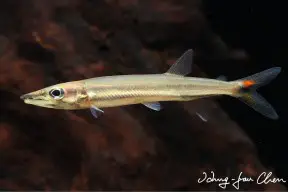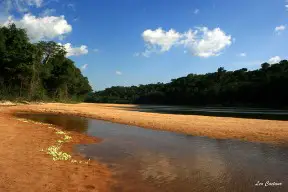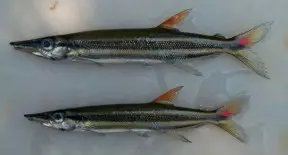Acestrorhynchus isalineae
Etymology
isalineae: named for Mrs. Isaline Drecq, wife of Mr. Guy van den Bossche, a participant in the expedition on which the species was discovered.
Classification
Order: Characiformes Family: Acestrorhynchidae
Distribution
The type series was collected from ‘tributary of Rio dos Marmelos, Rio Madeira basin, 110 kilometers east of Humaitá along rodovia Transamazônica, Amazonas State, Brazil’ in the western Brazilian Amazon, and most official records pertain only to this locality although the species may be more widely-distributed within the Madeira system.
Habitat
Maximum Standard Length
100 – 105 mm.
Aquarium SizeTop ↑
Acestrorhynchids are typically very active and extremely fast swimmers so minimum base dimensions in the region of 120 ∗ 45 cm are required even for a smaller species such as this.
Even juveniles need a significant amount of room since they tend to act skittishly in small tanks and can easily injure themselves by swimming into the glass.
Maintenance
The aquarium should ideally be designed to resemble a flowing stream or river with a substrate of variably-sized rocks, sand, fine gravel, and some larger water-worn boulders.
This can be further furnished with driftwood roots and branches if you wish but be sure to leave plenty of open swimming space.
Plants which can grow in sand can also be added as can those which prefer to be attached to solid surfaces such as Microsorum pteropus, Taxiphyllum barbieri or Anubias spp. while lighting can simply be tailored to the plants being used.
If using a deeper tank you could even fill it to 50-70% of capacity and add emergent branches or plants which can look very effective.
A tightly-fitting cover should be used in all cases since acestrorhynchids tend to be powerful jumpers.
Efficient filtration is a must when keeping predatory species due to the amount of waste produced so install one or more external canister filters and/or a sump system, organising the return in such a way that some surface movement is created.
Weekly water changes of 30-50% should be considered mandatory as this species can be sensitive to organic pollutants and swings in water chemistry, and for this reason it must never be introduced to biologically immature set-ups.
Water Conditions
Temperature: 24 – 28 °C
pH: 6.0 – 7.5
Hardness: 18 – 215 ppm
Diet
An obligate piscivore capable of consuming quite large prey in relation to its body size.
Newly-imported specimens may refuse to accept anything but live fishes although most can be weaned onto dead alternatives once they recognise them as edible, and some even learn to accept dried foods.
Like the vast majority of predatory fishes this species should not be fed mammalian or avian meat such as beef heart or chicken.
Some of the lipids contained in these cannot be properly metabolised by the fish and may cause excess fat deposits and even organ degeneration.
Similarly there is no benefit in the use of ‘feeder’ fish such as livebearers or small goldfish which carry with them the risk of parasite or disease introduction and at any rate tend not have a high nutritional value unless properly conditioned beforehand.
Behaviour and CompatibilityTop ↑
Relatively peaceful with anything too large to swallow and can be maintained in a community provided tankmates are chosen with care.
Aggressively territorial or very competitive species should be avoided with the best choices being placid fishes such as Geophagus spp., Acarichthys heckelii, medium-sized doradid or loricariid catfishes and characids from genera like Ctenolucius, Mylossoma or Myloplus.
This species is not aggressive towards conspecifics with juveniles in particular exhibiting a marked schooling instinct.
Older individuals tend to be more solitary but still group together from time-to-time, and it’s best maintained in numbers of four or more.
One important point to note is that acestrorhynchids are cannibalistic given the opportunity so if buying a group or adding to an existing school try to ensure that all individuals are of comparable size.
Sexual Dimorphism
Sexually mature females tend to grow a little larger and be deeper-bodied than males.
Reproduction
Observations of the congener A. falcatus suggest that spawning occurs in midwater with the female remaining stationary while the male swims around her in a ‘figure-of-eight’ pattern.
The eggs are scattered in large numbers and parental care is non-existent.
NotesTop ↑
This species is a member of the putative ‘A. nasutus group’ of closely-related species within the genus alongside A. nasutus, A. maculipinna and A. isalineae.
These are all characterised by possession of two dark, longitudinal stripes, one running from the tip of the snout to the caudal-fin base and the other from the posterior edge of the lower maxilla to the underside of the caudal peduncle.
Similar patterning is present in juvenile specimens of A. falcirostris although it’s clearly distinguishable by adult size with the other three species tending to grow no larger than 100 mm SL and retaining the body stripes into adulthood.
The remainder of the genus is currently composed as follows:
A. microlepis group: A. britskii, A. grandoculis, A. microlepis, A. minimus
A. nasutus group: A. falcirostris, A. nasutus, A. isalineae, possibly A. maculipinnis
Not assignable to any group: A. heterolepis.
The family Acestrorhynchidae appears most closely-related to the Cynodontidae which contains the genera Cynodon, Hydrolycus and Rhaphiodon.
References
- Géry, J., 1977 - T.F.H. Publications, Inc.: 1-672
Characoids of the World. - López-Fernández, H. and K. O. Winemiller, 2003 - Ichthyological Exploration of Freshwaters 14(3): 193-208
Morphological variation in Acestrorhynchus microlepis and A. falcatus (Characiformes: Acestrorhynchidae), reassessment of A. apurensis and distribution of Acestrorhynchus in Venezuela. - Menezes, N. A., 1969 - Arquivos de Zoologia (São Paulo) 18(1-2): 1-150
Systematics and evolution of the tribe Acestrorhynchini (Pisces, Characidae). - Prettia, V. Q., D. Calcagnottoa, M. Toledo-Piza and L. F. de Almeida-Toledo, 2009 - Molecular Phylogenetics and Evolution 52(2): 312–320
Phylogeny of the Neotropical genus Acestrorhynchus (Ostariophysi: Characiformes) based on nuclear and mitochondrial gene sequences and morphology: A total evidence approach. - Reis, R. E., S. O. Kullander and C. J. Ferraris, Jr. (eds.), 2003 - EDIPUCRS, Porto Alegre: i-xi + 1-729
Check list of the freshwater fishes of South and Central America. CLOFFSCA. - Toledo-Piza, M., 2007 - Zoological Journal of the Linnean Society 151(4): 691–757
Phylogenetic relationships among Acestrorhynchus species (Ostariophysi: Characiformes: Acestrorhynchidae).




February 25th, 2020 at 6:11 pm
I’m the owner of 2 A. isalineae.
The first one is exactly like the one showed on the first picture wich figure on the article.
The second show very rarely his melanistic patern (wich seems to correspond but i’m not 100% sure), the color tone is near green, and the fish is thicker than the first one.
I’m not sure if it’s two different species or just a sexual dimorphism.
Anyone has already maintain a couple of these?